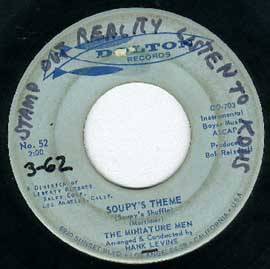 |
The Unofficial Duke&Banner Autobiography
"Criminals"
Before we begin we have an update on the LA Nuclear story. Tom Snyder, who began his broadcast career in LA right around the time of the January '65 Nuclear Experiment, has been diagnosed with Leukemia. The disease is recognized as a "marker" for Radiation Poisoning. Tom is 68.
Proof of the pudding is Snyder's younger brother, who was also diagnosed with Leukemia a year earlier. So far, our not-too-bright news media is labeling this as "suspicious."
Snyder is probably most remembered from his late-night NBC network talk shows. At one point, he was on the tube just after Johnny Carson.
This story is just beginning. And it's just the tip of the iceberg, folks. If you haven't read the whole story, it's HERE.
Near Brushes With The Law or: "Honest, Officer, It's Not My Fault!" |
By April of '66, I can't tell you how happy I was! Soon DHS would be a memory. A painful memory, but gone, like a malignant tumor-ectomy. Bob's train table became a semi-permanent studio table as regular broadcasting started. Yes, while other kids could claim hanging out at the hamburger stand after school, or stealing hubcaps...Bob and I became regular sidekicks on the radio, during what is now called Afternoon Drive.
In fact, Bob's house on Santo Domingo became a haven for friends of KDHS to see it in actual operation and to share...aah...personal things.
Get your mind outta the gutter! One friend, upon finding our fascination for Soupy Sales and pies, contributed his personal copy of "Soupy's Theme" by The Miniature Men (Actually Hank Levine of the KEWB/KFWB theme song.)
 |
But broadcasting every day will quickly get you in trouble. A week after we started, Bob confronted me:
Actual Duke&Banner Dialog: Bob: We got trouble. |
Before I lost too much sweat, I quickly realized I needed to pay a visit to our complainer. We put a long album on the VM and wandered over to his house. It wasn't far. Bob's house was situated on a sprawling acre, complete with a horse corral. But the infected TV set was only about 5 feet away from our broadcast antenna, in a converted garage. Problem was, even if we moved the antenna to the other side of the house, it would still be too close for comfort. But I tried to think positive.
The man was named Dan Lilly. He was young, but old. About 8 years older than us, and quickly showed us the problem. There, right in the middle of a "Candid Camera" re-run on KNXT-2, were bars running across the screen, making it almost impossible to view Allan Funt or Duward Kirby. To put it bluntly: Just like the vacuum cleaner he was named after, Durward Kirby's picture sucked. My eyebrows furrowed. This was serious! I begged the man not to call the FCC, and that I would do something about it.
I shut down KDHS and went back home to think about options. I really didn't want to move the station from Bob's ideal location, but the interference problem would have to be taken care of, pronto. But part of the problem was actually KNXT. Though they had their antenna high atop Mt. Wilson, their signal was pretty weak in Duarte. For the history of Mt. Wilson and LA TV click here.
How I solved the problem is probably explained better in Dan's
own words:
Obviously, I was upset, because the only channel that was being
interfered with was 2, and at that time, they had the most of the
best programming. Anyway, you put a capacitor (I think) between
the antenna terminals, and that took care of the problem.
As I recall, it was a couple of chokes (coils of wire) and a capacitor. But the fact was, McGiver had done it again, and in only one try! Dan was happy, Bob was happy, I was ecstatic! We left him with a clear picture of "My Favorite Martian," and I sorta identified with Ray Walston and the hidden antenna he kept in his head. Did the FCC ever arrest him?
Basically I was buying time. There were probably others who were probably getting crummy quality "Lucy Show" re-runs and would soon be complaining to the FCC. We were gaining enemies, and McGuyver quickly realized that he needed to find a better solution. Unfortunately not quickly enough.
In future chapters, Dan ends up as a key supporter of KDHS, and introduces us to a very important recording artist (especially during WWII) that we had never heard before: Spike Jones.
| L: Bob, Duke, Don P, Dan L, and Unknown. Taken at Arcadia Park. Arcadia's awful government boondoogles will be discussed in a future chapter. That soft drink 6 pack between the two shopping bags is "Bubble Up" Anybody remember the mid-60's jingle? "Bub-Bub-Bubble Up--A Kiss of Lemon, A Kiss of Lime--Bub-Bub-Bub-Bub-Bubble Up" |
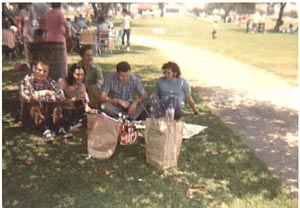 |
|
Spike Jones, the only man (besides
maybe |
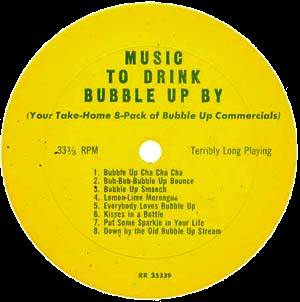 |
Believe it or not, for those of you who live in the LA area, you can still buy Bubble Up made with real sugar and in the original glass bottles! Click the bottle to find out more>>>>>>>>> |
 |
I can hear you all asking: "Hey Duke, what is this, an infomercial for some multinational corporation?!"
Fun With Physical Education |
OK, I want a show of hands. How many of you were the first to get picked for your High School Football Team? Your High School Baseball Team? How about Soccer?
What?! You were the last to be chosen? Oh, my! I'm sorry for you. But that's also where Bob and I stood, so you're in good company! Though Bob did like running (like a deer) his hand-eye coordination really sucked. Mine was a little better, but nothing to write home about. There was that Home Run back in '62, but other than that, I scored a zero, right behind Jim Salamone.
But we were so happy about Gym Class in our Senior year! Maybe Coach Fessler was giving us a present; maybe he had just given up on us. Hard to say, but for the final semester, Bob and I were given our own, exclusive area to gym: The track field! Fessler gave us specific instructions: we had to run laps, or otherwise be active for the hour.
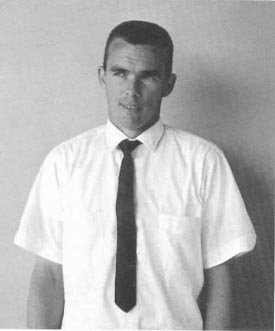 |
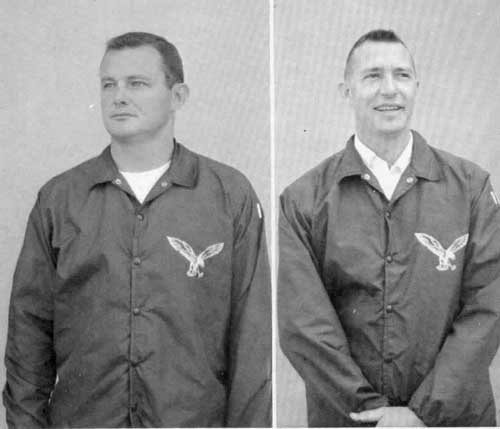 |
(L to R) (Howe was
apparently |
It was an uphill walk to the track, which also doubled as the field where all the home games were played, so there were numerous bleachers. The first day we sized up the situation: Fessler was probably not gonna check up on us. But even if he did, we had nothing to fear! We could sit in the bleachers (or under them on hot days) and should we see the coach, all we'd have to do is act like we were out of wind and had just finished a lap.
Yup, you guessed it! For the remainder of the school year, Bob and I could sit there and do nothing but talk about tubes and radios!! In actuality, I desperately wanted to broadcast the home games, but there wasn't an easy way to get a signal back to the Santo Domingo digs.
As I look back at this today, my mind boggles. How did Fessler know that Bob and I were like a team? And did he know that we were plotting unlawful exercises in Government Bureaucracy? Oh, MY!
"Hey Duke, the audio really sucks!" |
By the time I was satisfied with the coverage, leave it to Jim Salamone to call me up after hearing his show and complain: "Hey Doook, where's the bass? It sounds like a tin can compared to KFWB." Whereupon I asked Jim, "Are you a Taurus?" See, even then they were ganging up on me! However, while his sensitivity wasn't showing, White Man did speaketh the truth.
All good phonographs have what's called equalization. All it takes is a few capacitors and resistors, and you too, can sound just like KFWB. Some old VM turntables had humongous amounts of equalization, so you could turn down the highs and just hear a mellow background of your faves. KDHS at the time, had none. And the low-budget "flipover" crystal cartridges didn't help.
Believe it or not, there's an audio engineer who invented that wonderful bass/treble control circuit that was used in most Hi-Fi's and Stereos of the last century. PJ Baxendall was a British scientist who published his idea back in 1952 in a rag called Wireless World. It is unknown if he got any royalties for it, so the next time you adjust your bass, yell out: "PJ! PJ!"
And so, lying on the floor of my garage was a Heathkit mono amp that I found on the street. It was basically junk, but the preamp circuit worked. As a test, I connected it to my VM, cranked up the bass and treble, put on a bassy Motown record, and listened to the radio in my ma's '60 Falcon.
Oh MY! Boom-Boom; Tweet-Tweet! You should have seen all the dirt and dust jumping out of the dashboard speaker grill! The Supremes never realized it when they recorded "Come See About Me", but the full fidelity not only cleaned out the gunk from recessed speaker cones, it also washed away selected dashboard litter.
But, alas, there was something else missing: Compression (or Automatic Gain Control). Since AM radio is subject to interference from power line noise, fluorescent lights and such, most stations tried to be as loud as possible. For KRLA, this meant leaving the air from time to time as they overloaded the transmitter. For KDHS, it meant low-modulated parts of a record became hard to hear.
When I think back at how I solved this, I almost can't believe it. There were no kits, no army surplus units, and no actual schematics.
I found my answer in a Radio Shack parts catalog, called a photocell. Ahh, I can hear you all asking: "Hey Duke, what's a photocell, and does it take pictures of prison life?"
Oh, I'm so glad you asked that question! You must be psychic! First, how does a volume control work? It changes resistance as you turn the knob. How does a photocell work? It changes resistance by the amount of light you shine on it. Therefore, it's a simple procedure to glue one onto the business end of a flashlight, which is exactly what I did. The brighter the light gets, the more the photocell lowers resistance, and evens up the volume.
There was even better news! A standard PR-2 flashlight bulb ran perfectly from the 4 ohm speaker connections on the back of the amp. But there was also bad news. A standard flashlight bulb is very slow to act, so the first second of audio is at full blast, and distorted. Unfortunately they didn't have fast-acting, pleasant tasting LED's in 1965, though I could, and should have used a much faster neon light.
And it's too bad that I wasn't old or smart enough to patent my device. By the 80's, virtually every commercially made broadcast limiter had a few of these in the circuit. Hey, I want my royalties! (Pardon me as I sob)
Oh...I should also say that the Heathkit chassis marked the end of the pie tin chassis. Yeah!!! Anything I built from here on used real, honest-to-goodness thick-plated steel. Or is that steal?
Primitive KDHS Audio Limiter and Baxandall Equalizer made from Heathkit chassis. |
 |
 |
Modern Day equivalent using an
I.C. Total cost for parts, under 5 bucks! |
The Long Arm Of The Law! |
You think I had problems? Pappy Dow had real, real, really bad problems. It started with Monrovia's own Dilectron Capacitor company. Known nationally for it's high quality and tiny size, they were an instant hit. Many corporations, like where my dad worked at Aerojet General Corporation in Azusa, insisted on them.
Do you remember that back in chapter 8, where I discovered boxes of free parts in the back room of Electronics shop? Guess what? There were many Dilectrons in those boxes, so I helped myself to a handful or two. Or three....
And so, imagine Pappy Dow's face when a Temple City Sheriff's detective walked in and flashed a badge. Yup, just like Columbo, Pappy Dow was in hot water, and it was gettin' ready to boil. Some eye-witnesses said Dow's heart was pumping faster than an Iraqi oil well attempting to service President Bush.
The detective explained that an undercover man had visited Dow's store and purchased something illegal! Ahh, I can hear you all asking: "Hey Duke, what was the illegal substance? Was Pappy Dow pioneering a new brand of Medical Marijuana?" Heck No! It was Hot Capacitors! Dilectrons, to be precise. Turns out Dilectron had a break-in robbery about a month before that. Someone had jimmied the lock and hauled off a truckload of stuff, including thousands of capacitors.
Columbo held his cool, churning the cigar around in his mouth. "Hey Pappy, we got a notice to be on the lookout for .001, .002, and .047 disc capacitors. I was just wandering around and guess what I discovered on one of your dusty shelves? You know, you really oughta clean them someday...but I found three big boxes full of capacitors. And they're identical to the hot ones I'm holding in my hand. What do you have to say for yourself?"
"Are--are they stolen?!" Pappy Dow's face turned beet red.
"Right out of Dilectron's warehouse, Pap." A plume of gray smoke arose from the
cigar.
"But how was I supposed to know?"
Pappy Dow was correct. The Duartean newspaper, which should have been covering the story, was too busy with a series of 'How To Grow Better Hydrangea' articles. Anyway, real news is always so droll...
"Didn't you get our flyer that we sent to you?"
Columbo grinned.
"You mean that one with Jack Webb wearing a dirty trenchcoat
like yours?"
"Nah, we got a new one. It's got Kookie on the cover. You
know, 77 Sunset Strip?"
"Haven't seen it."
"You're a tough one, Pappy. So how about tellin' me where
you got those Dilectrons?"
"A man came in and offered them to me cheap."
"Really?! And what did he look like?"
"Shady."
"Why did he look shady?"
"Oh, I think he had an umbrella...."
And so, Pappy Dow got off the hook by giving a complete description of the criminal to the good lieutenant. Columbo, of course, confiscated the three boxes of Dilectrons, which gave me a very bad feeling. Was I also harboring stolen goods? Would Columbo show up on my doorstep asking strange questions and smoking up the whole area? My mind shuttered at the thought!
Ahh, I can hear you all asking: "Hey Bro Duke, wasn't Columbo popular in the 70's? And aren't we in '66?" Damn, haven't you ever heard of poetic license? And anyway I did mention Kookie, so bite your tongue, knave! At any rate, we're gonna jump ahead a few months for this next installment.
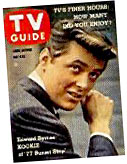 |
Gerald Kookson III K O O K I E ! |
"Hi! I'm Bobby Fuller..." |
Talk about crime! I may was one of the last people to interact with Bobby Fuller before his untimely death. The KRLA road show brought local rock acts to high school and college campuses in the LA area. In June of '66, that translated to The Bobby Fuller Four at Duarte High School.
Ironically, his signature song eventually became my theme song. At the time, I was a frustrated senior, having spent almost 4 years pleading, fighting, and trying to convince the high school bigwigs to give me Electronics class.
Bobby Fuller entered the Gym while I was playing hooky from English class. We only had one more week of school, and most classes were winding down anyway.
What was I doing alone in the gym? A scientific test. The Gym had 8 University extended-range horns, and they didn't work very well with the school's 100-watt Altec amplifier. Most of the time you either got distortion or squeal.
I had a home-modified 20-watt amp and a Calrad crystal microphone that resembled an old RCA ribbon microphone from the 40's. Crystal mikes have a tendency to sound like shit with the human voice, but they respond very well to ultrasonic frequencies. If ever you want to record a bat, consider using a crystal mike.
Bobby's first words when he saw a me manning a PA system for
him two hours in advance:
"Wow! You guys really got it together! Our band forgot to
bring the PA amplifier. This is great!"
His enthusiasm floundered, however, upon closer examination of
the mike:
"A crystal mike?! Oh, man..."
I hadn't tested it yet. I had no idea what it would sound like, but I was pretty sure I could make it sound OK with my modified Baxandall tone control circuit that I had just souped-up. So I cranked up the volume about 1/2 way and turned down the treble as far as my modifications could go, attempting to null out the squeak. I asked Bobby to test it.
He stepped up to the mike: "I fought the law and that law won..."
I couldn't believe it! This little 20-watt thing was echoing and reverberating all over the place, and clearly. No squeal, no distortion! Bobby took two steps back, looked at me, and said in astonishment: "This will do fine...just fine!"
He left the Gym, and I made the mistake of seeing just how loud it could go. I cranked up the volume until I heard feedback, then lowered it a bit and tried it myself. Mathematically, this can not be explained. 8 horns were getting a maximum of about 2-1/2 watts each, but the sound was really, really loud, and reverberating all over the gym.
Unfortunately reverberating too loud, for a nearby hall monitor was next to open up the gym door. Bobby was wheeling in a drum set when the monitor asked me for my hall pass. You remember hall passes, don't you? Those pieces of paper that make things legal? Not having the correct piece of paper, she ordered me out of the Gym. I reluctantly began to comply by disconnecting my amp.
"Wait! Where are you going with that amp?"
asked Bobby.
"It's my amp,"
I snorted back, "I want
to stay, but they
won't let me."
I assured Bobby that the school's Altec would work OK, and also had a better Electro Voice dynamic microphone.
Unfortunately the whole school lost that day. I was wrong. Dead wrong. The Altec did not work. In fact, it blew up during rehearsal! Charles Pearce, legally setting up the school amp with a hall pass, tried to fix it but was unsuccessful. So, in it's place, an amplified lectern, which probably didn't have more than a few watts, attempted to amplify Bobby's voice.
From my seat, about the middle of the gym, I listened to the mainly instrumental sounds of I Fought The Law And The Law Won, and thought about how appropriate the song was!
The law did win; the whole school lost.
| Actual page from Halconado: Top (L) Bobby Fuller singing into amplified lectern via the EV microphone. Bottom (R) Bobby Fuller Four Publicity Photo. Anybody know who's in the other photos? |
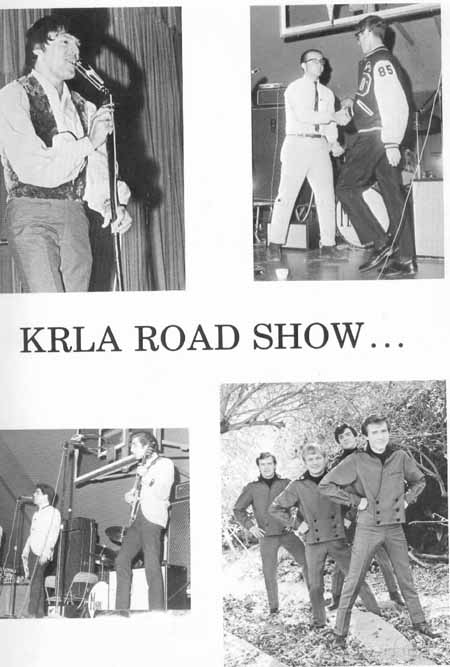 |
He's Dead Jim |
The Death of Bobby Fuller is quite a legend. It made it to the TV show Unsolved Mysteries, and will probably never be solved. What is known points fingers in many directions. After researching this, I'm beginning to realize that Bobby's association with Bob Keane makes it even more suspicious, and makes me wonder if Ritchie Valens wasn't murdered, along with Buddy Holly and The Big Bopper. The coincidences are sorta interesting:
Ritchie Valens |
Bobby Fuller |
| Died after 3 hits produced
by Keane Keane paid for airplay Valen's popularity was fading Valens' idol: Buddy Holly |
Died after
3 hits produced by Keane |
Was Bobby Fuller murdered? Ask his brother, Randy Fuller, as interviewed by Aaron J. Poehler: "Bobby never mentioned 'the mob'...but to get a record on KRLA or KFWB was almost impossible by an unknown band. (unless you're crooked and pay money, and in this case they even knew when the record was going to air, to the exact minute)
The Bobby Fuller Four recordings with Keane took a phenomenal amount of engineering. Lots of highs, lots of bass, and crystal clear. But no engineering feat will get you airplay in LA, especially from an unknown artist.
Keane created the Mustang label for Fuller, since the band was from Texas. The subsidiary Bronco label was formed for Barry White, also from Texas, and not yet a Blues crooner. White was paid $40 a week to manage it.
At any rate, on Monday, July 18th, a month after I met him, he was dead.
Here come the strange parts: Jim Reese was a guitarist for the Bobby Fuller Four. He was getting drafted and going to Viet Nam, so he sold his shiny new Jaguar XKE to Bobby. But that's not where they found the body. Loraine (Fuller's Mom) owned a rusty Oldsmobile sedan. It had been missing since 3AM the night before, and it wasn't there when she checked the mailbox at 4PM. At 4:30PM, worried band members pounded on her door and they searched the neighborhood. She discovered the Olds in the parking lot of her apartment at 5PM. In it was Bobby.
"He was lying in the front seat," Loraine said, "The keys were in the ignition, and his hand was on the keys, as if he had tried to start the car. I thought he was asleep. I called his name. When I looked closer, I could see he wasn't sleeping…he was dead."
Strange Occurance#1: Why is Bobby not in the car he just purchased? And if he did commit suicide, why did he do it in his mother's car, whom he loved?
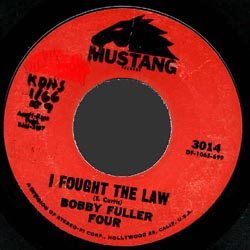 |
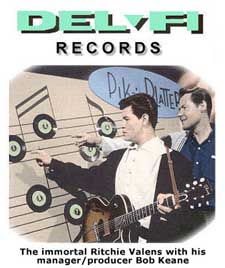 |
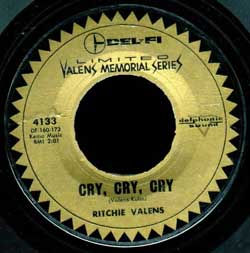 |
The official Bob Keane version goes a little deeper
It was sometime during the hot late afternoon hours of Monday, July 18th, that Bobby Fuller's body was found, lying across the front seat of his mother's Oldsmobile. The car had mysteriously appeared after hours of searching. The doors were unlocked, the windows were closed tight, and no keys to the vehicle were found inside. When the first Hollywood-division police officers arrived and opened the driver's side door, they noticed there was a book of matches on the front seat beside Fuller. An eyewitness to the gruesome discovery remembers that Fuller had traces of dried blood around his chin and mouth, and that his face and chest were bruised as if he had been beaten. Fuller's hair and clothing were also soaked with gasoline, and his right hand still clenched a rubber siphoning-tube.
Crime scene investigators made so many baffling errors in judgment that it seems some kind of "police cover-up" may have actually taken place.
Strange Occurance#2: According to the police report, the body was in a full state of rigor mortis, meaning it had to have been dead for at least 3 hours. Bobby's mother, and other eyewitnesses stated that the car wasn't in the parking lot at 4PM, therefore, in order for it to be there at 5PM, it had to be driven there, and not by Bobby!
An empty gas can, found in the back seat, was removed by a policeman (who apparently didn't consider it vital to the investigation) and thrown into a nearby dumpster. The Olds was not dusted for fingerprints, nor was it ever impounded, nor was it searched for further clues.
Strange Occurance#3: LAPD not only throws evidence in a dumpster, and refuses to investigate further?!
Members of the radio and television press at the scene were told that it looked to be a clear case of "suicide" despite much visual evidence to the contrary, and this off-hand remark was the first news of Fuller's death to be broadcast to the world. Many people still believe what they first heard that day to be the truth, and despite the fact that a coroner's autopsy report---which originally listed the death as suicide---was changed months later to read "accidental" due to "inhalation of gasoline." (The accompanying case report also stated that Fuller had been "despondent over job situation recently.")
There were also rumors that he had actually drank gasoline, though a Stanford University crime professor reported (in 1966) that "no one has ever successfully killed themselves by drinking gasoline. One could not be able to keep it down, even if they could get it down. They would simply throw up before they could die from it." Another rumor was that Fuller had overdosed on LSD or some other kind of hallucinogenic drug at a Malibu Beach party the night before. The people at the parties were celebrities, and to avoid a scandal, they poured gasoline down his throat, saturated his hair and they planned to torch the car---to make it look like a "mob slaying"--yet no trace of drugs appear in the autopsy report, and no traces of gasoline had actually been swallowed.
Fuller was buried four days later at Forest Lawn Cemetery in Burbank. Case closed.
There was some truth to the fact that Fuller had been depressed in the weeks just prior to his death, but never suicidal. He was disappointed that a planned European tour, where the band was immensely popular, had just been cancelled.
Bobby's mother Loraine, told LAPD that Bobby had begun playing one particular sad ballad on his stereo over and over while sitting alone in his bedroom with the lights off, and that he was depressed, but not suicidal.
Forty years later, the facts still don't add up to suicide. So what other possibilities are there? It has been reported that the autopsy report, released five months later, was inconclusive and provided few clues as to the actual cause of death. There were several numerous bruises on his face and upper torso; unmistakably, it was an act of extreme violence, and certainly not an "accidental death."
Strange Occurance#4: The body has been beaten up, but LAPD doesn't find it suspicious?! What is this? Cop-ola?!
At the time of his death, Fuller had been keeping company with a young woman named "Melanie," whose ex-boyfriend was a jealous club owner reported to be tied to the local crime syndicate.
Strange Occurance#5: Local crime syndicate with ties to 'The mob'. (By the mob, we mean the Italian Mafia)
Other mysterious circumstances took place in the days just after the discovery of Fuller's body. A private investigator, hired by Fuller's parents and Bob Keane, quit the case a few days later after he was shot at by a would-be assassin.
"Melanie" disappeared and has not been heard from since. The private investigator was on her tail when he was almost murdered. He reported it to LAPD, who dispatched a black and white unit, but did absolutely no follow up.
After Bobby's death, band member Dalton Powell had been confronted by "three real mean-looking dudes" who had come to the apartment he shared with band member Reese, looking for the guitarist, telling Powell they would return. Fearing their lives, Powell and Reese left town after Fuller's funeral and never returned to California.
Randy Fuller and the band's road manager, Rick Stone, were nearly run off the road one evening by a car that had been following them.
Strange Occurance#6: How many people have to run for their lives before LAPD finally gets a damn clue?!
Bobby was buried just 2 days later, on July 20. Band member Dalton Powell summed it up at the funeral: "Anyone who would rule this a suicide is either totally incompetent or scared to death."
Strange Occurance #7: Man, that was a quick autopsy!
But remember, the above is the official Del-Fi/Mustang/Bob Keane version, designed to insulate Del-Fi.
Aaron Poehler may have gotten closer to the facts, and it points some rather large fingers. Let's start with the official LAPD report: The last person to see Bobby alive was Lloyd Esinger, manager of the apartment building. He said Bobby stopped by his apartment about 3 AM and they had a few beers. He recalled that Bobby "was in good spirit and definitely not suicidal." It was the last time anyone can confirm seeing Bobby alive.
Then there's the "partner." Mustang/Bronco was a joint venture of Keane and Billy Cardenas. Cardenas had just ended his gig with Downtown LA's Rampart Records, a local Hispanic label noted for its custom 45RPM labels that pictures their artists dressed up in white tuxedos. But Bobby Fuller's band members state that Keane also took on an unidentified partner for "I Fought The Law." The purpose of the partner was to provide enough money for heavy airplay on radio stations nationwide. This sort of a venture costs mucho dinero, and is generally associated with underworld characters trying to launder money.
Another small detail the Keane version doesn't mention is the life insurance policy. Band member Dalton Powell sez: "I had my (Keane provided) insurance policy canceled because I was worth a lot more dead to certain people, and I wasn't taking any chances." Randy recalls that there was also a life insurance policy on Bobby for between $800,000 and $1 million, payable to the aforementioned investor in Del-Fi/Mustang, who was rumored to have underworld connections, according to Poehler's interview.
Did Ritchie Valens have a big insurance policy payable to someone? Could that plane crash not be an accident? We haven't found any evidence, but remember the common denominator: Valens, Fuller & Holly were no longer releasing "hits." Out on the charts just prior to Buddy Holly's death is a little ditty called "Heartbeat" that peaked at #82, and the Holly release previous to that peaked at #68. (To be fair, the official FAA report says the pilot in the Beechcraft Bonanza was not certified for instrument flying, and most likely made an unwise decision to fly in deteriorating weather conditions, where it crashed in the snow at Mason City, Iowa. However, to show you how easy this can be done, lets say a mobster pays a kid $10,000 to fly the trio, knowing full well he has a high probability to crash. If it crashes, the mobster gets the $80,000 insurance settlement. If not, he's only out $10,000. It's like a lottery. Easy, ain't it?)
Dalton noted: "We worked off and on for some real ugly people…I think there were people behind the scenes that just considered us an investment. Maybe they saw it as their $1 million investment about to fly out the window and they wanted to make sure they got something out of it."
Randy Fuller says he knows that strings were pulled at LAPD. Besides the premature ruling of suicide, Randy says they never checked the gas can found with Bobby for prints, and when one of his uncles went down to the police station begging for an investigation, "They told him if he knew what was good for him, he'd better keep his mouth shut."
Poehler's version says Melanie wasn't just Bobby's girlfriend, but a paid sex kitten to keep Bobby happy and to act as an intermediary between Bobby and her boyfriend. He suggests that her boyfriend was, in fact, Keane's shady partner. The official LAPD investigation quotes her as saying: "I have 100% no mob connections, and neither did Bobby…The most illegal thing might have been what was called payola, but no one ever talked about it."
Strange Occurance #8: Let's analyze this comment a little. The nightclub that Melanie works for "that has no mob connections" is called PJ's. Funny thing about this club, but it has very strong ties to Reprise records, co-owned by Frank Sinatra. Though you won't find Sinatra or Dean Martin there, you'll find lots of smaller acts, like Eddie Cano, Trini Lopez, Aki Aleong, Mort Sahl, Page Cavanaugh, Do Ho, Sandy Shaw, The Blendells, and even The Kinks. Virtually the entire Reprise line-up.
Sinatra's connection the 'The Mob' is legendary. He has an FBI record of over 2400 pages investigating one facet of his mob affiliation, though nothing was ever proven. But with PJ's strong tie to Sinatra's record company, it becomes obvious: Melanie works for The Mob. And you can chalk up another strange co-incidence with Trini Lopez. The first person who got him a recording contract? Buddy Holly!
In the book "Sinatra, the life" Sonny King, a good friend of Sinatra states: "The mob controlled the clubs, the jukebox rackets, and had their hook into every facet of the music industry."
But it goes deeper than that. The authors state: Lee Harvey Oswald’s killer Jack Ruby was in touch with someone from Sinatra’s record company shortly before the assassination. A week after the President Kennedy's murder, Frank Jr. was kidnapped (and his ear cut off.) Sinatra worried that the kidnapping was a message from the mob, warning him to stay silent about anything he might know about the Mafia's role in the assassination. Late in life, Sinatra said privately that he did not believe the Warren Commission’s "lone assassin" verdict. He said more than that, but the friend with whom he shared the information will not elaborate.
Here's a link to Sinatra's biography. Scroll down to view his extensive mob affiliations.
As a postscript, Randy Fuller reminisces about 1966 LA: "Put it this way, when you're a kid back in the 50's and you're seeing Elvis Presley…and all the girls screamin', you're sayin' that's what I want to do! Your whole dream is to get out of this hick Texas town and go to California.
Then Bob Keane gets this new partner, who comes into the picture and tells us, 'Tomorrow starting at such and such a time, they're gonna be playing I Fought The Law…every hour on the hour." We're drivin' down the freeway and that song comes on and man...the adrenaline flowed and the goosebumps popped up, and we cranked up the radio full blast! It's just the greatest feelin' in the world! We're on our way...we're gonna be millionaires...we're doin' what we really wanna do...and then...it's gone (snaps fingers) just like that."
Final Plot Twists:
No one ever collected on that insurance policy. Even the insurance company thought something was afowl, and refused to pay Keane or his partner.
Plot Twist, 1969: MGM records somehow got the rights to release a Ritchie Valens Golden Hits album. Mike Curb was the new president of MGM at the time, and personally arranged the deal. He had to, because he fired just about everyone at the company, including the entire A&R department, engineering department, staff producers, promotions department, distribution staff and most of the accounting department! Why in the hell would he even bother? Most everyone already owned the Del-fi album!
Plot Twist, 1970: Curb did other crazy things at MGM. One year into his gig as head cheeze, and he makes a public announcement, stating he's going to fire any artist who is using drugs. That promps Eric Burdon to make his own public statement, boasting that he smoked Medical Marijuana, and encouraging Curb to fire him. (At the time, Burdon had a #3 hit, nationally) Curb declines the offer, but 6 months later signs Donny Osmond and the entire squeaky-clean Osmond clan to the MGM roster. ICK!
Plot Twist, 1973: Curb is canned. MGM bigwigs are angry that the record company is nearly bankrupt, and without proper staff in the MGM records accounting department, they find it very hard to point fingers. He was fired in for hiding and skimming profits---and get this---for possible connections to the mob, including money laundering!
There's that mob connection again! Even more suspicious was MGM bigwigs' unwillingness to prove the accusations. All they did was fire him, and try to pick up the pieces.
Plot Twist, 1978:Yes, Curb is a Republican. He went on to become the Lieutenant Governor of California, under Governor Moonbeam. (Jerry Brown, currently Governor of Oakland, Ca.)
Plot Twist, 1980:After they dumped Curb, MGM seems to have gotten in on the insurance gig bandwagon. First a fire at their Hollywood studios, then a fire at their high-rise MGM Grand hotel in Las Vegas, where many people died. Think these were accidents? Think again!
Plot Twist, 2004: According to a KLAS-TV investigation, a recently retired police inspector named Phil Hilliard had evidence that the MGM Grand fire was intentionally set. But when Hilliard took the information to his superiors: “I was told by the lieutenant in charge: ‘We don't want 85 murders on the wall. The fire department ruled it accidental, and you'd better back off it,’ ” said Hilliard.
Though he followed orders, within four months, Hilliard, Chuck Lee and almost everyone else in their unit were transferred out of homicide. KLAS-TV has learned the lieutenant who gave the order to keep quiet is John Connors. He died a few years ago. [Ed note: How convieient!]
Plot Twist, 1994: Kevin Hackie, a former Death Row Records body guard and FBI informant testified under oath in front of a Criminal Grand Jury that he witnessed a Death Row executive paying $25,000 to an LAPD cop, for the murder Rap star The Notorious B.I.G. He also said that he knew quite a few other LAPD cops who were corrupt and would murder people for the right price. He is placed in the witness protection program. Geez, how many Angelinos have been murdered by rogue LAPD officers?
Plot Twist 2005: Eleven years, and the trial is still going on?! Kevin Hackie testifies that whatever he said to the Criminal Grand Jury, he can't remember, and doesn't wish to testify. The judge in the case, The Honorable Florence Cooper, asks Hackie if he feared for his life, noting that Hackie was fidgeting on the witness stand. Hackie denies any fear for his life, but Cooper uncovers evidence that LAPD has been holding back large amounts of evidence. She calls a mistrial, and yells at the bank of LAPD lawyers: "It is absolutely incredible that a law enforcement agency can act with this much disrespect for the law." So...now we have a Federal Official that says LAPD is corrupt, and very capable of falsifying information about the murder of Bobby Fuller, and others.
Plot Twist, 2005: Bob Keane has written a book. He sums it up: "Bobby Fuller's death is still a mystery to me as it is to everyone. I don't believe it will ever be solved. In my book I go into the mystery quite extensively, and it will undoubtedly open many new questions. However, it won't solve the mystery." Yeah, thanks, Bob......
|
Whew! We've spent alot of time on this subject! It was quite exhausting, but we wanted to make sure that we got the story straight, and I thank you for hanging in there! COMING NEXT CHAPTER: Local Drive In Movie Theatres
& Improving Sound |
||
Chapter 12 |
|||
Deep Thoughts: I've often wondered what would have happened to me had the Hall Monitor not interviened. That could have been the start of my career. That may have been my link to a gig at KRLA, or Del-Fi. It may also have been my link to an early death. It's hard to say, but talking about this still opens up some painful wounds, and I thank you for having the fortitude to real all of it!